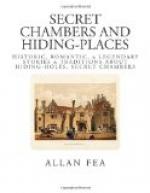The sanguinary laws against seminary priests and “recusants” were enforced with the greatest severity after the discovery of the Gunpowder Plot. These were revived for a period in Charles II.’s reign, when Oates’s plot worked up a fanatical hatred against all professors of the ancient faith. In the mansions of the old Roman Catholic families we often find an apartment in a secluded part of the house or garret in the roof named “the chapel,” where religious rites could be performed with the utmost privacy, and close handy was usually an artfully contrived hiding-place, not only for the officiating priest to slip into in case of emergency, but also where the vestments, sacred vessels, and altar furniture could be put away at a moment’s notice.
It appears from the writings of Father Tanner[1] that most of the hiding-places for priests, usually called “priests’ holes,” were invented and constructed by the Jesuit Nicholas Owen, a servant of Father Garnet, who devoted the greater part of his life to constructing these places in the principal Roman Catholic houses all over England.
[Footnote 1: Vita et Mors (1675), p. 75.]
“With incomparable skill,” says an authority, “he knew how to conduct priests to a place of safety along subterranean passages, to hide them between walls and bury them in impenetrable recesses, and to entangle them in labyrinths and a thousand windings. But what was much more difficult of accomplishment, he so disguised the entrances to these as to make them most unlike what they really were. Moreover, he kept these places so close a secret with himself that he would never disclose to another the place of concealment of any Catholic. He alone was both their architect and their builder, working at them with inexhaustible industry and labour, for generally the thickest walls had to be broken into and large stones excavated, requiring stronger arms than were attached to a body so diminutive as to give him the nickname of ‘Little John,’ and by this his skill many priests were preserved from the prey of persecutors. Nor is it easy to find anyone who had not often been indebted for his life to Owen’s hiding-places.”
How effectually “Little John’s” peculiar ingenuity baffled the exhaustive searches of the “pursuivants,” or priest-hunters, has been shown by contemporary accounts of the searches that took place frequently in suspected houses. Father Gerard, in his Autobiography, has handed down to us many curious details of the mode of procedure upon these occasions—how the search-party would bring with them skilled carpenters and masons and try every possible expedient, from systematic measurements and soundings to bodily tearing down the panelling and pulling up the floors. It was not an uncommon thing for a rigid search to last a fortnight and for the “pursuivants” to go away empty handed, while perhaps the object of the search was hidden the whole time within a wall’s thickness of his pursuers, half starved, cramped and sore with prolonged confinement, and almost afraid to breathe, lest the least sound should throw suspicion upon the particular spot where he lay immured.




